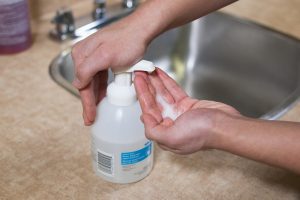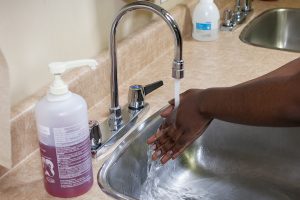Chapter 1: Introduction
Therapeutic Environment and Informed Consent
It is important to seek informed consent while creating a therapeutic and safe environment during all encounters with clients. You will usually begin by introducing yourself by name and designation so the client knows who you are. Next, explain what you are going to do and always ask permission to touch before beginning vital sign measurement. For example, an appropriate introduction is:
It is also important to ensure the client’s privacy by closing the curtains or the door to the room.
Infection Prevention and Control
Clean hands and clean equipment are essential to infection prevention and control when measuring vital signs. Ensuring cleanliness helps reduce communicable and infectious diseases, particularly health care-associated infections, which are infectious organisms acquired by a client while in hospital. Common infections include clostridium difficile (C. diff), vancomycin-resistant enterococcus (VRE), and methicillin-resistant staphylococcus aureus (MRSA).
Ensuring your hands are clean is the best way to prevent and control infection. Hand hygiene can include cleansing with hand gel (see Figure 1.1) and hand washing. (see Figure 1.2). Use an alcohol-based sanitizer before and after contact with clients. Place gel on your hands and rub all hand surfaces for at least fifteen seconds. When washing hands using soap and water, wet your hands and apply soap. Rub all hand surfaces for about fifteen seconds, then rinse your hands. If the tap is not automatic, then turn it off with a paper towel.
Points to Consider
Hand gel is the preferred method of hand hygiene because it kills more bacteria and is easily accessible to healthcare providers. Soap and water is used when hands/gloves come into contact with bodily fluids.

Figure 1.1: Hand gel
Test Yourself!
While watching the interactive video on applying hand gel, apply your knowledge and critical thinking skills by answering the questions throughout the video. Please note: there is no sound in this video.

Figure 1.2: Hand washing
Test Yourself!
While watching the interactive video on hand washing, perform the skill along with the student while applying your knowledge and critical thinking skills to answer the questions throughout the video. Please note: there is no sound in this video.
Equipment
Healthcare providers always inspect equipment before use to ensure it is in good working condition. Equipment (e.g., stethoscopes, pulse oximeters) can be cleaned with alcohol-based solutions to disinfect the surfaces. Automated devices should be regularly serviced to ensure accuracy. Biomedical technicians/experts are responsible for preventative maintenance and calibration to optimize functioning.
Click on the hotspots to learn about the following pieces of equipment:
Pain Assessment
A pain assessment is conducted in conjunction with the measurement of vital signs because pain can influence the findings. Pain can activate the sympathetic nervous system and increase pulse, respiration, and blood pressure. Pain is a complex issue, and a comprehensive discussion of pain assessment is beyond the scope of this e-book.
Briefly, because pain is subjective, self-reports are the most effective way to assess pain. The choice of pain assessment tool depends on the client situation: healthcare providers frequently use a numeric rating scale such as “rate your pain on a scale of 0 to 10 with zero being no pain and ten being the very worst pain that you have ever felt.” The response is often recorded on the vital sign record and expanded on in the narrative notes. Another common tool is the PQRSTU mneumonic in which each letter corresponds to a series of questions.
- P – Provocative/Palliative (e.g., What makes the pain worse? What makes the pain better?)
- Q – Quality/Quantity (e.g., Can you describe what the pain feels like? How bad is the pain?)
- R – Region/Radiation (e.g., Where is the pain located? Does it radiate anywhere else?)
- S – Severity (as noted above, rate the pain on a scale of zero to ten)
- T – Timing/Treatment (When did the pain begin? Is it constant? Have you taken anything to help the pain? If so, what?)
- U – Understanding (What do you think is causing the pain?)
Order of Vital Sign Measurement
The order of vital sign measurement is influenced by the client situation. Healthcare providers often place the pulse oximeter probe on a client while proceeding to take pulse, respiration, blood pressure, and temperature. However, in some situations this order is modified and the healthcare provider needs to critically assess the situation to prioritize the vital sign measurement order. For example, with newborns/infants, it is best to proceed from least invasive to most invasive, so it is best to begin with respiration, pulse, oxygen saturation, temperature and if required, blood pressure. In an emergency situation or if a person loses consciousness, it is best to begin with pulse and blood pressure. Generally, it is important to conduct a complete set of vital signs unless otherwise indicated.
Significance of Measurements
Determining the significance of vital sign measurements involves a process of diagnostic reasoning. The healthcare provider analyzes client data and makes decisions about whether the vital signs are normal or abnormal and whether the findings are significant: the following chapters provide normal vital sign ranges. The healthcare provider also considers agency policy, if applicable, about vital sign ranges to assess any abnormal variations and clinical significance. Additionally, the healthcare provider considers the client’s baseline vital signs to obtain a better sense of the client’s ‘normal’ and allow comparison (e.g., of trends) over time. The diagnostic reasoning process also involves considering other available objective and subjective data.
Documentation
Timely documentation of vital sign measurements is imperative as a form of communication, to observe trends in vital sign measurements, and to ensure effective intervention when needed. Documentation occurs on paper-based vital sign records or electronic systems depending on the agency. Healthcare providers follow the agency’s documentation policy and the professional standards of practice. If using a vital sign record, healthcare providers use the symbols noted on the legend of the record.

